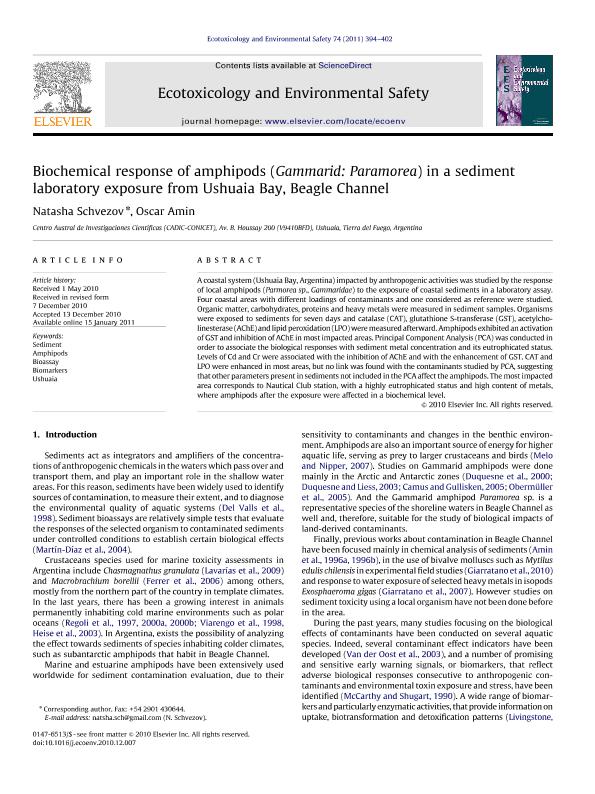Artículo
Biochemical response of amphipods (Gammarid: Paramorea) in a sediment laboratory exposure from Ushuaia Bay, Beagle Channel
Fecha de publicación:
01/2011
Editorial:
Elsevier Inc
Revista:
Ecotoxicology and Environmental Safety
ISSN:
0147-6513
Idioma:
Inglés
Tipo de recurso:
Artículo publicado
Clasificación temática:
Resumen
A coastal system (Ushuaia Bay, Argentina) impacted by anthropogenic activities was studied by the response of local amphipods (Parmorea sp., Gammaridae) to the exposure of coastal sediments in a laboratory assay. Four coastal areas with different loadings of contaminants and one considered as reference were studied. Organic matter, carbohydrates, proteins and heavy metals were measured in sediment samples. Organisms were exposed to sediments for seven days and catalase (CAT), glutathione S-transferase (GST), acetylcholinesterase (AChE) and lipid peroxidation (LPO) were measured afterward. Amphipods exhibited an activation of GST and inhibition of AChE in most impacted areas. Principal Component Analysis (PCA) was conducted in order to associate the biological responses with sediment metal concentration and its eutrophicated status. Levels of Cd and Cr were associated with the inhibition of AChE and with the enhancement of GST. CAT and LPO were enhanced in most areas, but no link was found with the contaminants studied by PCA, suggesting that other parameters present in sediments not included in the PCA affect the amphipods. The most impacted area corresponds to Nautical Club station, with a highly eutrophicated status and high content of metals, where amphipods after the exposure were affected in a biochemical level.
Palabras clave:
Sediment
,
Amphipods
,
Bioassay
,
Biomarkers
,
Ushuaia
Archivos asociados
Licencia
Identificadores
Colecciones
Articulos(CADIC)
Articulos de CENTRO AUSTRAL DE INVESTIGACIONES CIENTIFICAS
Articulos de CENTRO AUSTRAL DE INVESTIGACIONES CIENTIFICAS
Citación
Schvezov, Natasha; Amin, Oscar Antonio; Biochemical response of amphipods (Gammarid: Paramorea) in a sediment laboratory exposure from Ushuaia Bay, Beagle Channel; Elsevier Inc; Ecotoxicology and Environmental Safety; 74; 3; 1-2011; 394-402
Compartir
Altmétricas




